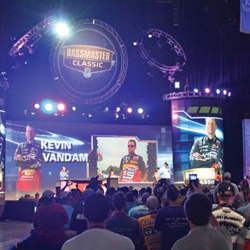
Considerable Attention
“A key aspect to understand with a project of this nature is that it is a TV show first, so you have to treat it that way,” explains Schmidt, who served as the event’s production manager.
“All of the production elements have to take this into account, and with respect to sound, it has to be invisible, because camera sightlines and a clean broadcast picture are paramount.”
However, there is also the matter of providing commensurate concert-level sound reinforcement for the thousands in attendance at the venue each evening, and it was an aspect that garnered considerable attention from the Reel Rock Productions sound team – Dennis Cooper, Ed Vertuno, and Jim Apgar – a veteran group who’s most “junior” member has 25 years of experience.
The highlight of each night’s show had every contestant aboard his boat, towed into the arena to the stage via pickup truck for the weigh-in of his catch that day.
This meant 50 weighins on each of the first two nights, and 25 as the field was narrowed on the final night, each only about two and a half minutes apart.
To streamline this parade, the stage was angled so that upon entering the arena, the trucks had a straight path – but it meant that the stage was angled 45 degrees from a typical “square” placement. The result was a challenging coverage situation.
“There was definitely some unusual geometry, particularly in contrast to a typical concert situation in an arena,” Schmidt notes.

“However, we determined that a left and right flown array configuration was still the correct approach, even though the arrays would have to be placed differently than usual and the delivery times between the two sides would differ greatly.
“In addition, and this comes out very clearly when you look at in drawing form, you see that the stage right array would actually be covering more of the room than the stage left array,” he adds.
The team performed initial plotting of array location and coverage, and then added an out fill array to each side as well to fill any potential gaps, particularly on the extreme sides of the coverage area.
Just Right
Schmidt also discussed the situation with his long-time colleague and friend Brian English, director of concert system solutions for QSC Audio and a veteran of many unique sound reinforcement situations, to get his input as well.
And in fact, English decided to venture to New Orleans at the outset of the production load-in to collaborate with Schmidt on the system programming and deployment.
CAD drawings helped form the primary layout and positioning well ahead of time, and then once on site, the team did a lot of adjustment and optimization of the arrays to get things just right.
The Rational Acoustics Smaart platform also proved particularly helpful in synchronizing the various time arrivals.
